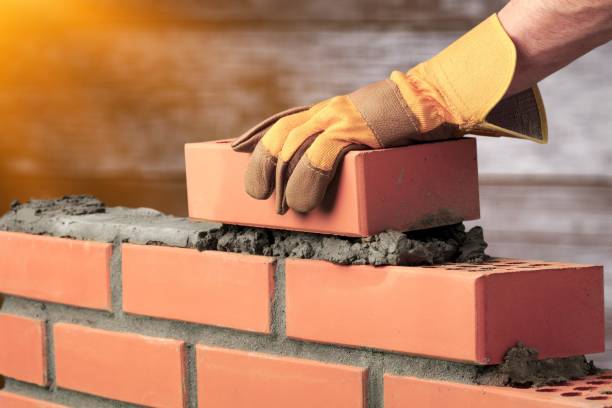The Definitive Guide to Bricklayer Auckland
Wiki Article
An Unbiased View of Bricklayer Auckland
Table of ContentsThe smart Trick of Bricklayer Auckland That Nobody is Talking AboutNot known Incorrect Statements About Bricklayer Auckland A Biased View of Bricklayer AucklandNot known Details About Bricklayer Auckland Getting The Bricklayer Auckland To WorkAbout Bricklayer Auckland
The scaffolding called for should be planned prior to the work starts. It needs to be built in such away as to cause the least interference with various other staff participants. Blocks ought to constantly be stacked on slabs; never pile them straight on unequal or soft ground. Do not save bricks on scaffolds or runways.Except where piled in sheds, brick stacks need to never be greater than 7 feet high. When a heap of block gets to a height of 4 feet, it needs to be tapered back 1 inch in every foot of elevation above the 4-foot degree. The tops of brick heaps should be maintained level, as well as the taper have to be preserved during unpiling procedures.
Architectural bond refers to just how the individual masonry units interlock or tie with each other right into a solitary structural device. Using grout to stick surrounding wythes of masonry.
Excitement About Bricklayer Auckland
Pattern bond refers to the pattern developed by the masonry units and also mortar joints on the face of a wall surface (Bricklayer Auckland). The pattern might arise from the structural bond, or it might be purely ornamental as well as unconnected to the structural bond. Figure 4-4 reveals the six basic pattern bonds alike usage today.The running bond is the simplest of the 6 patterns, including all cots. Since the bond has no headers, metal ties normally create the architectural bond. The running bond is utilized largely in dental caries wall surface construction, block veneer wall surfaces, as well as facing tile wall surfaces made with extra vast cot tile.
Great blocks need to not break down when placed in water. Just when fat lime or clay mortar is utilized or when one is forced to use bricks that are not well burned, this soaking policy has to be loosened up.
Bricklayer Auckland - The Facts
In all instances, bricks need to not be managed in baskets or in any kind of other setting which will ruin the sharpness of their edges. A layer of mortar is spread to cover the full width of the wall for an ideal length of the lower training course.
We push the side bulging mortar in strongly to be level with the face of the wall surface if it is to be left unplastered. In the common technique adopted by many masons, a row of bricks is very first positioned on a thin layer of bed mortar leaving the cross joints empty.


Strictly this is not a good method. (Nonetheless, when utilizing cement mortar of high toughness, the loss of stamina as a result of offense of these policies may be only marginal.)The walls are elevated really plumb. All programs are laid genuinely horizontal and also all upright joints truly upright. Upright joints in alternative programs should come straight, one over the various other.
Excitement About Bricklayer Auckland
For this purpose, a wooden straight edge with graduation offering a density of each brick course consisting of joint can be utilized for guidance. For a thick wall surface, the above operation is duplicated in addition to both faces of the wall surface and the interior loading blocks for the thick wall surface are laid in a comparable fashion.
This operation of loading open joints is labelled flushing-up. It is wrongly omitted for numerous courses on some badly-executed work and just done afterwards (not after every training course) in an inefficient fashion. It is not an excellent method as well as ought to be prevented as it is essential that every course should be flushed up to the degree if great is required.

How Bricklayer Auckland can Save You Time, Stress, and Money.
The mortar rising and also filling up the upright joints entirely and creates an exceedingly solid and also solid wall. This is called larrying. For a rat trap bond work (as in the construction of dental caries wall surfaces), if the mortar is placed thoughtlessly on the brick, a few of it will come under the cavities and also will be wasted.The face of the brickwork will likewise be cleansed of all mortar droppings, etc(ii) When scenarios render it required to bring on a portion of a structure in uneven training courses, the job shall be constructed back (according to the bond utilized on the work) at an angle not steeper than 45 degrees so as to guarantee an attire and reliable bonding.
Or else, for faces to be plastered, completing of the face joints should be performed as reviewed in listed below (This is really crucial.)(iv) The wall surfaces ought to be evenly increased all around not leaving any kind of component one metre (3 visite site feet) less than the various other - Bricklayer Auckland. A day's work ought to not be greater than 1.
The Only Guide to Bricklayer Auckland
When the facework is to be later plastered or the see this here joints alone are to be sharp, the joints have to be raked while the wall surface is being constructed. Bricklayer Auckland. It should be raked to a minimum depth of 12 mm by a raking tool during the progression of the work itself, when the mortar is still environment-friendly.
If plastering or aiming is not imagined, the joints have to be struck flush and completed at the time of laying itself, as already specified. Half-brick walls have a tendency to fracture unless treatment is absorbed its building. Brickwork in half-brick masonry is to be carried out with stretchers in 1: 5 mortar.
Report this wiki page